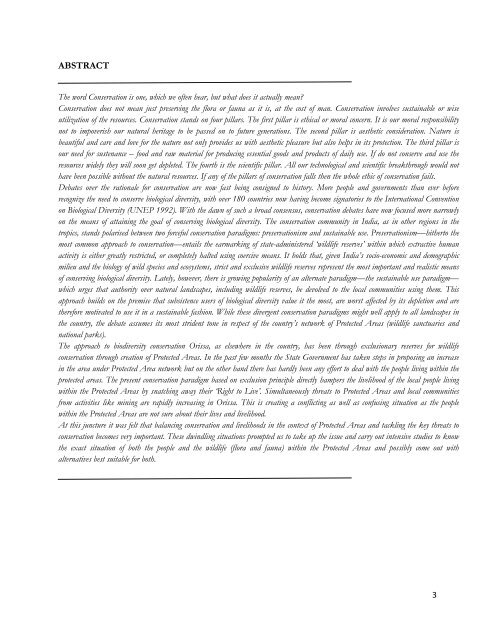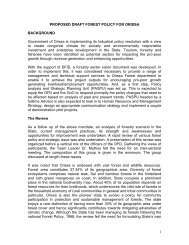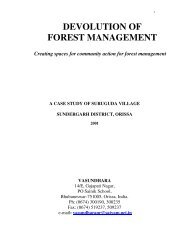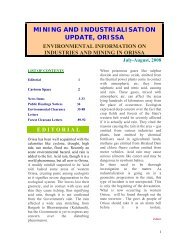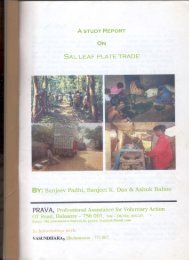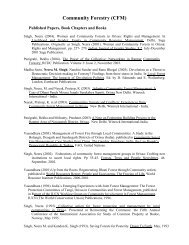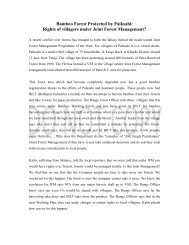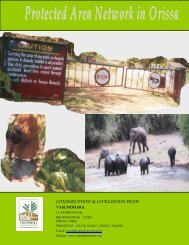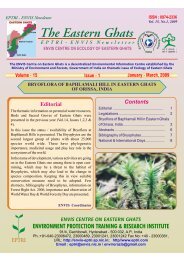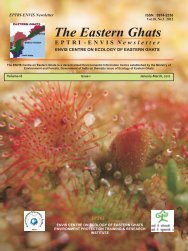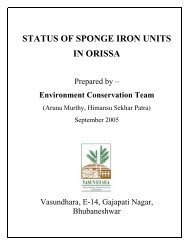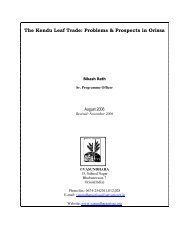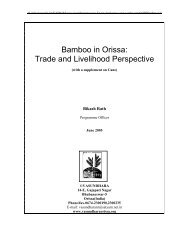Impact of NTFP ban on the lives and livelihood of the ... - Vasundhara
Impact of NTFP ban on the lives and livelihood of the ... - Vasundhara
Impact of NTFP ban on the lives and livelihood of the ... - Vasundhara
You also want an ePaper? Increase the reach of your titles
YUMPU automatically turns print PDFs into web optimized ePapers that Google loves.
ABSTRACTThe word C<strong>on</strong>servati<strong>on</strong> is <strong>on</strong>e, which we <str<strong>on</strong>g>of</str<strong>on</strong>g>ten hear, but what does it actually mean?C<strong>on</strong>servati<strong>on</strong> does not mean just preserving <strong>the</strong> flora or fauna as it is, at <strong>the</strong> cost <str<strong>on</strong>g>of</str<strong>on</strong>g> man. C<strong>on</strong>servati<strong>on</strong> involves sustainable or wiseutilizati<strong>on</strong> <str<strong>on</strong>g>of</str<strong>on</strong>g> <strong>the</strong> resources. C<strong>on</strong>servati<strong>on</strong> st<strong>and</strong>s <strong>on</strong> four pillars. The first pillar is ethical or moral c<strong>on</strong>cern. It is our moral resp<strong>on</strong>sibilitynot to impoverish our natural heritage to be passed <strong>on</strong> to future generati<strong>on</strong>s. The sec<strong>on</strong>d pillar is aes<strong>the</strong>tic c<strong>on</strong>siderati<strong>on</strong>. Nature isbeautiful <strong>and</strong> care <strong>and</strong> love for <strong>the</strong> nature not <strong>on</strong>ly provides us with aes<strong>the</strong>tic pleasure but also helps in its protecti<strong>on</strong>. The third pillar isour need for sustenance – food <strong>and</strong> raw material for producing essential goods <strong>and</strong> products <str<strong>on</strong>g>of</str<strong>on</strong>g> daily use. If do not c<strong>on</strong>serve <strong>and</strong> use <strong>the</strong>resources widely <strong>the</strong>y will so<strong>on</strong> get depleted. The fourth is <strong>the</strong> scientific pillar. All our technological <strong>and</strong> scientific breakthrough would nothave been possible without <strong>the</strong> natural resources. If any <str<strong>on</strong>g>of</str<strong>on</strong>g> <strong>the</strong> pillars <str<strong>on</strong>g>of</str<strong>on</strong>g> c<strong>on</strong>servati<strong>on</strong> falls <strong>the</strong>n <strong>the</strong> whole ethic <str<strong>on</strong>g>of</str<strong>on</strong>g> c<strong>on</strong>servati<strong>on</strong> fails.Debates over <strong>the</strong> rati<strong>on</strong>ale for c<strong>on</strong>servati<strong>on</strong> are now fast being c<strong>on</strong>signed to history. More people <strong>and</strong> governments than ever beforerecognize <strong>the</strong> need to c<strong>on</strong>serve biological diversity, with over 180 countries now having become signatories to <strong>the</strong> Internati<strong>on</strong>al C<strong>on</strong>venti<strong>on</strong><strong>on</strong> Biological Diversity (UNEP 1992). With <strong>the</strong> dawn <str<strong>on</strong>g>of</str<strong>on</strong>g> such a broad c<strong>on</strong>sensus, c<strong>on</strong>servati<strong>on</strong> debates have now focused more narrowly<strong>on</strong> <strong>the</strong> means <str<strong>on</strong>g>of</str<strong>on</strong>g> attaining <strong>the</strong> goal <str<strong>on</strong>g>of</str<strong>on</strong>g> c<strong>on</strong>serving biological diversity. The c<strong>on</strong>servati<strong>on</strong> community in India, as in o<strong>the</strong>r regi<strong>on</strong>s in <strong>the</strong>tropics, st<strong>and</strong>s polarised between two forceful c<strong>on</strong>servati<strong>on</strong> paradigms: preservati<strong>on</strong>ism <strong>and</strong> sustainable use. Preservati<strong>on</strong>ism—hi<strong>the</strong>rto <strong>the</strong>most comm<strong>on</strong> approach to c<strong>on</strong>servati<strong>on</strong>—entails <strong>the</strong> earmarking <str<strong>on</strong>g>of</str<strong>on</strong>g> state-administered ‘wildlife reserves’ within which extractive humanactivity is ei<strong>the</strong>r greatly restricted, or completely halted using coercive means. It holds that, given India’s socio-ec<strong>on</strong>omic <strong>and</strong> demographicmilieu <strong>and</strong> <strong>the</strong> biology <str<strong>on</strong>g>of</str<strong>on</strong>g> wild species <strong>and</strong> ecosystems, strict <strong>and</strong> exclusive wildlife reserves represent <strong>the</strong> most important <strong>and</strong> realistic means<str<strong>on</strong>g>of</str<strong>on</strong>g> c<strong>on</strong>serving biological diversity. Lately, however, <strong>the</strong>re is growing popularity <str<strong>on</strong>g>of</str<strong>on</strong>g> an alternate paradigm—<strong>the</strong> sustainable use paradigm—which urges that authority over natural l<strong>and</strong>scapes, including wildlife reserves, be devolved to <strong>the</strong> local communities using <strong>the</strong>m. Thisapproach builds <strong>on</strong> <strong>the</strong> premise that subsistence users <str<strong>on</strong>g>of</str<strong>on</strong>g> biological diversity value it <strong>the</strong> most, are worst affected by its depleti<strong>on</strong> <strong>and</strong> are<strong>the</strong>refore motivated to use it in a sustainable fashi<strong>on</strong>. While <strong>the</strong>se divergent c<strong>on</strong>servati<strong>on</strong> paradigms might well apply to all l<strong>and</strong>scapes in<strong>the</strong> country, <strong>the</strong> debate assumes its most strident t<strong>on</strong>e in respect <str<strong>on</strong>g>of</str<strong>on</strong>g> <strong>the</strong> country’s network <str<strong>on</strong>g>of</str<strong>on</strong>g> Protected Areas (wildlife sanctuaries <strong>and</strong>nati<strong>on</strong>al parks).The approach to biodiversity c<strong>on</strong>servati<strong>on</strong> Orissa, as elsewhere in <strong>the</strong> country, has been through exclusi<strong>on</strong>ary reserves for wildlifec<strong>on</strong>servati<strong>on</strong> through creati<strong>on</strong> <str<strong>on</strong>g>of</str<strong>on</strong>g> Protected Areas. In <strong>the</strong> past few m<strong>on</strong>ths <strong>the</strong> State Government has taken steps in proposing an increasein <strong>the</strong> area under Protected Area network but <strong>on</strong> <strong>the</strong> o<strong>the</strong>r h<strong>and</strong> <strong>the</strong>re has hardly been any effort to deal with <strong>the</strong> people living within <strong>the</strong>protected areas. The present c<strong>on</strong>servati<strong>on</strong> paradigm based <strong>on</strong> exclusi<strong>on</strong> principle directly hampers <strong>the</strong> <strong>livelihood</strong> <str<strong>on</strong>g>of</str<strong>on</strong>g> <strong>the</strong> local people livingwithin <strong>the</strong> Protected Areas by snatching away <strong>the</strong>ir ‘Right to Live’. Simultaneously threats to Protected Areas <strong>and</strong> local communitiesfrom activities like mining are rapidly increasing in Orissa. This is creating a c<strong>on</strong>flicting as well as c<strong>on</strong>fusing situati<strong>on</strong> as <strong>the</strong> peoplewithin <strong>the</strong> Protected Areas are not sure about <strong>the</strong>ir <strong>lives</strong> <strong>and</strong> <strong>livelihood</strong>.At this juncture it was felt that balancing c<strong>on</strong>servati<strong>on</strong> <strong>and</strong> <strong>livelihood</strong>s in <strong>the</strong> c<strong>on</strong>text <str<strong>on</strong>g>of</str<strong>on</strong>g> Protected Areas <strong>and</strong> tackling <strong>the</strong> key threats toc<strong>on</strong>servati<strong>on</strong> becomes very important. These dwindling situati<strong>on</strong>s prompted us to take up <strong>the</strong> issue <strong>and</strong> carry out intensive studies to know<strong>the</strong> exact situati<strong>on</strong> <str<strong>on</strong>g>of</str<strong>on</strong>g> both <strong>the</strong> people <strong>and</strong> <strong>the</strong> wildlife (flora <strong>and</strong> fauna) within <strong>the</strong> Protected Areas <strong>and</strong> possibly come out withalternatives best suitable for both.3


